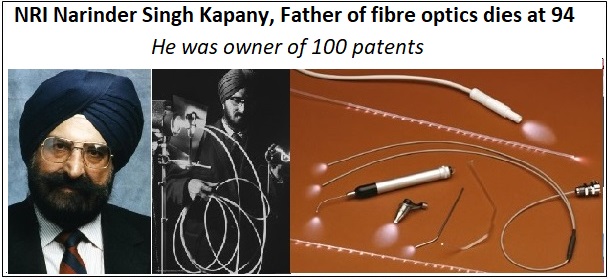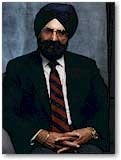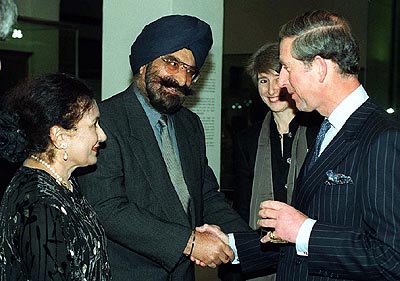| Connecting
over 25 millions NRIs worldwide |
|
|||||||||||||||||||||||
|
||
Narinder Kapany, Ph.D. Founder and Chairman "In high school, a teacher told Kapany that light could travel
only in a straight line. Kapany set out to prove him wrong and wound
up creating fiber optics." (Fortune Magazine, 1999) His career has spanned science, entrepreneurship and management, academia, publishing, lecturing, and farming. His personal interests include philanthropy, art collecting, and sculpting. As a scientist, Dr. Kapany is widely acknowledged as the father of fiber-optics. His research and inventions have encompassed fiber-optics communications, lasers, biomedical instrumentation, solar energy and pollution monitoring. He has over one hundred patents, and was a member of the National Inventors Council. He has received many awards including 'The Excellence 2000 Award' from the USA Pan-Asian American Chamber of Commerce in 1998. He is a Fellow of numerous scientific societies including the British Royal Academy of Engineering, the Optical Society of America, and the American Association for the Advancement of Science. As an entrepreneur and business executive, Dr. Kapany has specialized in the processes of innovation and the management of technology and technology transfer. In 1960, he founded Optics Technology Inc. and was Chairman of the Board, President, and Director of Research for twelve years. In 1967 the company went public with numerous corporate acquisitions and joint-ventures in the United States and abroad. In 1973, Dr. Kapany founded Kaptron Inc. and was President and CEO until 1990 when he sold the company to AMP Incorporated. For the next nine years, Dr. Kapany was an AMP Fellow, heading the Intrapreneur & Technical Expert Program and serving as Chief Technologist for Global Communications Business. He recently founded K2 Optronics. He has also served on the boards of various companies. He was a member of the Young Presidents Organization and is presently a member of the World Presidents Organization. As an academic, Dr. Kapany has taught and supervised research activity of postgraduate students. He was a Regents Professor at the University of California, Berkeley (UCB), and at the University of California, Santa Cruz (UCSC). He was also Director of the Center for Innovation and Entrepreneurial Development (CIED) at UCSC for seven years. At Stanford University, he has been a Visiting Scholar in the Physics Department and Consulting Professor in the Department of Electrical Engineering. As an author and lecturer, Dr. Kapany has published over 100 scientific papers and four books on opto-electronics and entrepreneurship. He has lectured to various national and international scientific societies. As a philanthropist, Dr. Kapany has been active in education and the arts. He has been the founding chairman and major funder of the Sikh Foundation and its activities for over 30 years. In collaboration with international institutions and publishers, the Foundation runs programs in publishing, academia and the arts. In 1998, Dr. Kapany endowed a Chair of Sikh Studies at the University of California, Santa Barbara. His gift in 1999 of $500,000 to the Asian Art Museum of San Francisco will establish a gallery in its new building displaying the works he has donated from his collection of Sikh art. In 1999, he endowed a Chair of Opto-Electronics at the University of California, Santa Cruz. He is also trustee of the University of California, Santa Cruz Foundation. He has served as a trustee of the Menlo School in Menlo Park, California. As an art collector, Dr. Kapany has specialized in Sikh art. He was the prime mover and a provided a major loan of paintings for the internationally acclaimed 'Arts of the Sikh Kingdoms' exhibition. The exhibition started in March 1999 at the Victoria & Albert Museum, London, proceeded to the Asian Art Museum of San Francisco with the Sikh Foundation as its major sponsor, and opened in May 2000 for four months at the Royal Ontario Museum in Canada. The exhibition follows 'Splendors of the Punjab: Sikh Art and Literature in 1992' organized by Dr. Kapany in collaboration with the Asian Art Museum and UC Berkeley to celebrate the 25th anniversary of the Sikh Foundation. As an artist, Dr. Kapany has created 40 "dynoptic" sculptures which were first displayed in a one-man show at the Exploratorium of the Palace of Fine Arts in San Francisco in 1972. Since then, the collection has been viewed at museums and art galleries in Chicago, Monterey, Palo Alto, and Stanford.
|
||
|
Dr. Narinder Singh Kapany |
|
If one beam of light can be transmitted along a glass tube, why not transmit detailed images along the same path? The problem has steadily resisted the best efforts of optical researchers. But now the University of Rochester's Indian-born Dr. Narinder Singh Kapany, 30, has succeeded by applying a technique he refers to as "fiber optics." With his new method, he has already designed a glass "gastroscope" which can be snaked down the throat for a detailed closeup view of the human stomach. Fiber optics derives its name from its use of hair-thin strands of optical glass as light carriers. Light entering an ordinary clear glass or plastic rod is reflected over and over again from the inner surface until it emerges again at the far end. This familiar principle causes the rod to act as a "light pipe." Dr. Kapany conceived the idea of bunching thousands of microscopic glass rods, each of which would transmit a single point of light. The bundle of points of light should form an image in much the same way the pattern of ink dots in a newspaper illustration forms a picture. With the aid of Bausch & Lomb tech nicians, Dr. Kapany made up several glass-fiber bundles, each of them containing up to a quarter of a million individual strands a thousandth of an inch in diame ter. So long as he kept the fiber's ends in the same relative position at each end of the bundle, he found that he could pass exact images through the flexible bundles even when they were tied in knots.
|



